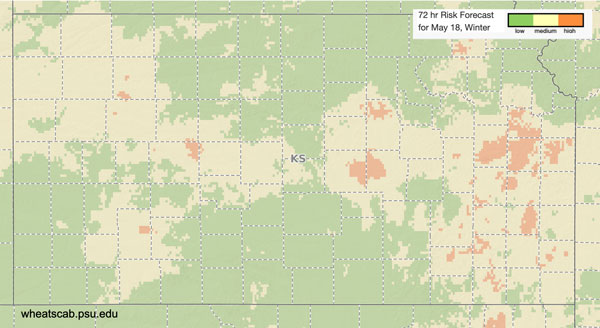Wet weather in many parts of Kansas this week are favorable for both Fusarium head blight (FHB or scab) and stripe rust development. In this article, we walk through some reminders for fungicide applications for each of these diseases.
The 72-hour forecast is looking favorable for scab development in several parts of the state according to wheatscab.psu.edu (Figure 1). At the highest risk are fields of scab-susceptible varieties that are currently at the flowering growth stage during this wet weather. Fields with a previous history of FHB or with corn residue should be prioritized for a fungicide application.

Figure 1. Fusarium head blight (scab) risk including forecasted weather for 72 hours after May 18, 2021. Red areas indicate regions with the most favorable forecasted weather. This model is calibrated for susceptible varieties of winter wheat.
Reminders for scab fungicide applications
Products
Fungicides such as Prosaro, Caramba, Proline, or Miravis Ace are known to suppress scab (head blight). Specific fungicide performance for scab and other diseases can be found here: https://bookstore.ksre.ksu.edu/pubs/EP130.pdf. Other fungicides are not labeled or not recommended for scab control.
Timing
These fungicides are most effective against scab when applied at early flowering (Feekes 10.5.1), but can provide protection even when applied later in the flowering window. It is important to pay attention to pre-harvest intervals at this point of the season and follow guidelines provided on product labels. The products listed above have either a 30-day pre-harvest interval (cannot be applied within 30 days of harvest) or cannot be applied after Feekes 10.5.4 (end of flowering, watery ripe growth stage).
It is important to remember that early flag-leaf fungicide applications will have little to no effect on scab.
Rainfastness
With the current, wet weather, we are getting many questions about fungicide rainfastness. Rainfast time is defined as the period of time that needs to pass between the application of a fungicide and a rainfall event where the fungicide will not loose efficacy. This information is often not included on the product label, or is ambiguous. Rainfast time will be variable with temperature and canopy moisture, but generally most products recommended for wheat in Kansas will be rainfast within two hours, and likely within one hour under most conditions.
Residual life
The residual life of the fungicide application is influenced by the product used, environment, and rate of application. In general, products belonging to the triazole and strobilurin classes of fungicide will run out of gas (you may start to see symptoms) after 21 days. Small differences in residual life among products typically do not result in large differences in grain yield. Some newer products are promoted as having longer residual lives, but we don’t yet have the university research to support those claims.
A vast majority of the labeled fungicides for wheat in Kansas will not provide protection for new growth (only leaves present at the time of application are protected).
Reminders for stripe rust fungicide applications
Stripe rust has continued to increase in prevalence and severity across the state (Figure 2). As of now, levels remain low in northwestern counties but recent, wet weather has increased risk in that region. The fungicides recommended above for scab control (Prosaro, Caramba, Proline, or Miravis Ace) are each excellent for stripe rust control. If scab is not a concern, there are many more products that are also excellent or very good for stripe rust control. Be sure to check the K-State wheat fungicide guide for results from multi-state, multi-year studies on product efficacy: https://bookstore.ksre.ksu.edu/pubs/EP130.pdf. Again, be sure to double check labels for pre-harvest intervals.
Timing is key for successful stripe rust control. It is recommended to scout fields and make applications before stripe rust is detected in 10% of plants for best yield protection.

Figure 2. Distribution of stripe rust in Kansas as of May 18, 2021. Map is based on observations of K-State Research and Extension, crop consultants, ag industry colleagues, and wheat producers in the state. Map created by Kelsey Andersen Onofre, K-State Research and Extension.
Kelsey Andersen Onofre, Extension Wheat Pathologist
andersenk@ksu.edu
Tags: wheat fungicide stripe rust fusarium head blight head scab